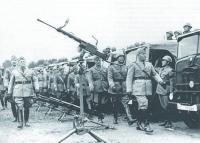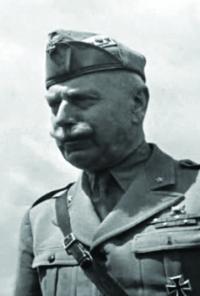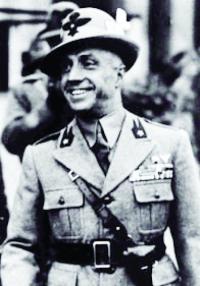
Mussolini sending C.S.I.R. to Russia.

Italo Gariboldi

Savoy cavalry in Russia.

The Retreat

Luigi Reverberi, commander Tridentina Division

Italian P.O.W.’s
This month 70 years ago, the Red Army was engaged in the destruction of the Eighth Italian Army or "Armata Italiana in Russia - ARMIR," commanded by Italo Gariboldi. From March 25, 1941 to July 19, 1941 General Gariboldi had served as the Governor-General of Libya and commander of the Axis forces in North Africa. On January 4, 1943, der Führer would present him with Germany’s highest award for bravery - the Knight’s Cross.
The ARMIR was created in July 1942 when, in response to the German Führer’s call for increased participation by the other Axis countries, the Italian Duce sent four infantry divisions - Sforzesca, Ravenna, Cosseria and Vicenza - and three mountain divisions - Tridentina, Julia and Cuneense - to the Eastern Front. These new divisions, joined two motorized divisions - Torino and Pasubio - and the Principe Amedeo Duca d’Aosta Cavalry Division. These last three divisions comprised the Corpo di Spedizione Italiano in Russia - CSIR - which had been formed on July 10, 1941 and sent to the Eastern Front that summer under the command of General Giovanni Messe.
The German Führer’s attitude to Italian participation, in 1942, stood in stark contrast with his attitude in 1941. It was with great reluctance that the German Führer accepted the Italian Duce’s contribution in 1941. Hitler felt - correctly - that Italian efforts would have been better served closer to home, in the North African Theater. He couldn’t understand why the Italians thought they were in a position to help the Germans with Operation Barbarossa, when only a few months earlier they had needed German assistance to stave off complete collapse and the loss of Libya. One can only imagine the effect that the 18,000 trucks and artillery tractors, 946 artillery pieces, 300 antitank guns and 52 anti-aircraft guns would have had on the North African campaign if, instead of being squandered in Russia, they had been incorporated into Field Marshal Erwin Rommel’s Panzerarmee Afrika.
CSIR had been attached to Panzergruppe I, under the command of German General Ewald von Kleist. ARMIR was assigned to Army Group B, under the Command of General Baron Maximilian von und zu Weichs an der Glon. ARMIR was divided into three Corps - the XXXV, II, and the Mountain, Corps.
The XXXV Corps, which was the original CSIR, was commanded by Francesco Zingales, who had replaced General Messe in November 1942, because he was constantly complaining to Rome of the materiel deficiencies of his troops. The three original CSIR divisions - Torino, Pasubio and the Principe Amedeo Duca d’Aosta were commanded by respectively, Roberto Lerici, Vittorio Giovannelli and Mario Marazzani. The Croatian Legion, commanded by Lt. Col. Egon Zitnik, was attached to General Marazzani’s Principe Amedeo Duca d’Aosta Division. The XXXV Corps also contained the following: German 298th Infantry Division, commanded by Arnold Szelinski; 3 Gennaio brigade of Blackshirts, commanded by Filippo Diamanti; and a company of the elite Bersaglieri.
The II Corps was commanded by Giovanni Zanghieri and contained the Ravenna, Sforzesca and Cosseria Infantry Divisions commanded by Francesco Dupont (who replaced Edoardo Nebbia after his capture on October 3, 1942), Carlo Pellegrini and Enrico Gazzale. This corps also contained 23 Marzo Camice Nere, commanded by Enrico Francisci. The Blackshirts, or Camice Nere, were the rough equivalent of the German SS units, in that the Camice Nere were the committed Fascists, without, however, the training, leadership and superior equipment of the SS. The 23 Marzo was so named to honor the date of the founding of the Fascist Party, by Benito Mussolini, on March 23, 1919. 3 Gennaio Camice Nere was named for the date when the Fascists took control of the Italian Parliament on January 3, 1925.
The Mountain Corps was probably the best trained and equipped, especially for the Russian winter, of any of the Italian units. It was commanded by Gabriele Nasci. He had previously commanded a corps in Greece. The Tridentina, Julia and Cuneense Alpine Divisions were commanded by Luigi Reverberi, Umberto Ricagno and Emillio Battisti. All three commanders would be captured by the Red Army.
The Vicenza Division, commanded by Etelvoldo Pascolini, guarded the Italian supply and communication from partisan attack.
By August, the Italians had taken their position between the Second Hungarian Army, commanded by Vitéz Gusztáv Jány, and the Fourth Rumanian Army, commanded by Knight’s Cross holder Petre Dumitrescu, on the Don River. It was no accident that they were sandwiched between the Hungarians and Rumanians. If left to their own devices, the Rumanians and Hungarians would be fighting each other. In fact, in August of 1944, when Rumania switched sides, this is exactly what occurred! Much of this animosity stemmed from the Transylvania problem. As a result of the Second Vienna Award, half of it had been awarded to the Kingdom of Hungary, in an arbitration presided over by Italian and German Foreign Ministers Count Galeazzo Ciano and Joachim von Ribbentrop. Neither country was happy. Both wanted it all.
On August 20, the Soviets thought they saw an opportunity and launched an assault on the Italians. The Italians held, and after three days, launched a counterattack with General Marazzani’s Principe Amedeo Duca d’Aosta cavalry division. On August 24, 1942, the Savoy cavalry regiment launched history’s last cavalry charge, resulting in 150 enemy dead, 600 captured and at least 300 wounded, at a cost of 39 killed and 74 wounded, and 170 horses lost. The horse carrying the regiment’s standard bearer returned to Italian lines, riderless and blind in one eye - but with the regiment’s colors! Everything was quiet on the Italians’ front from then until December.
In November, the Red Army had crashed through General Dumitrescu’s Fourth Rumanian Army and the Third Romanian Army, commanded by Constantin Constantinescu-Claps, which had been guarding the flanks of the German Sixth Army as it ground its way into Stalingrad. Now, the city, and Sixth Army, were surrounded by the Soviets. On December 12, Army Group Don, under the command of Field Marshal Eric von Manstein attempted to lift the siege. Although good progress was made the first day, by the second day Soviet resistance was stiffening.
On December 16, the Red Army’s Southwestern Front launched Operation Little Saturn against General Gariboldi’s Eighth Army. The Southwestern Front was commanded by Nikolai Fyodorovich Vatutin, one of the Red Army’s most talented commanders. He would be mortally wounded by Ukrainian partisans in the winter of 1944.
General Vatutin’s Southwestern Front consisted of the First and Third Guards Armies and the Sixth Army, commanded by, respectively: Vasily Kuznetsov; Dmitry Danilovich Lelyushenko and Fedor Mikhailovich Kharitonov. A Soviet army received the appellation of "Guards" because it had distinguished itself. For instance, the First Guards Army had, until November, been the 63rd Army. It had performed very well in the defense of Stalingrad, ergo its new designation.
By the time of the Soviet offensive, the 8th Italian Army totaled 235,000 men, was equipped with 988 guns, 420 mortars, 25,000 horses and 17,000 vehicles. However, it was woefully short of tanks and antitank guns. There was very little that could stop the Soviet T-34 Medium, or KVII heavy tanks. The small arms were problematic as well. And, other than the Alpini, the soldiers were not properly clothed to meet the Soviet ally, General Winter.
By December 18, the Soviet First Guards and Sixth Armies had destroyed the XXXV and II Corps and the Croatian Legion. This left only General Nasci’s Mountain Corps. In temperatures as low as -40F, the Corps led the survivors 150 miles west to the new Axis positions and safety - all the while emulating the Emperor Napoleón’s Grande Armée, fending off the Cossacks. On January 26, 1943, the Corps reached the village Nikolayevka, (since absorbed into the village of Livenka which has a population of 4,000) which was defended by a Soviet division. By now the Corps had been swelled to 40,000 by Hungarians and Germans fleeing the onrushing Red Army. However, only General Reverberi’s Tridentina Division was still combat worthy. After a day of combat the Soviets still held the village which barred the road to safety. Finally, General Reveberi climbed onto one of the last three tanks, yelled, "Tridentina, Avanti!," and led his men forward on a last desperate charge, which dislodged the Soviets and allowed the survivors to get to safety. General Batisti’s Cuneense Division was annihilated and the General captured. General Ricagno’s Julia Division suffered a 90 percent loss including its commander, who was captured, while General Reverberi’s Tridentina suffered a 2/3 loss.
Losses sustained by the ARMIR were devastating - 30,000 killed, 34,000 wounded and 60,000 captured, of which 10,000 eventually returned home.
The Red Army would drop the hammer on General Vitéz Jány’s Second Hungarian Army in January. Of 200,000 soldiers, 40,000 returned home.
NEXT: KASSERINE PASS
Mr. Wimbrow writes from Ocean City, Maryland, where he practices law representing those persons accused of criminal and traffic offenses, and those persons who have suffered a personal injury through no fault of their own.
«Go back to the previous page.





